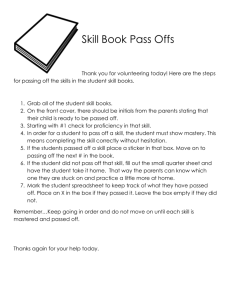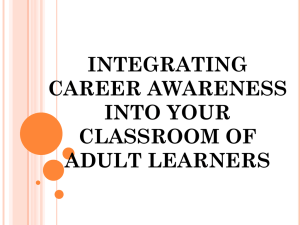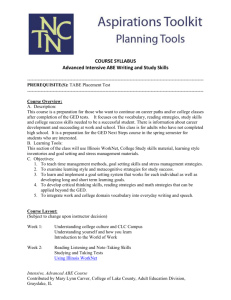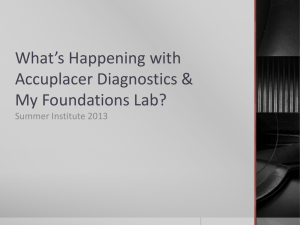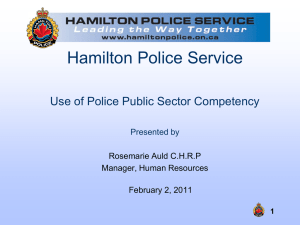Pilot Competency Completion Options
advertisement
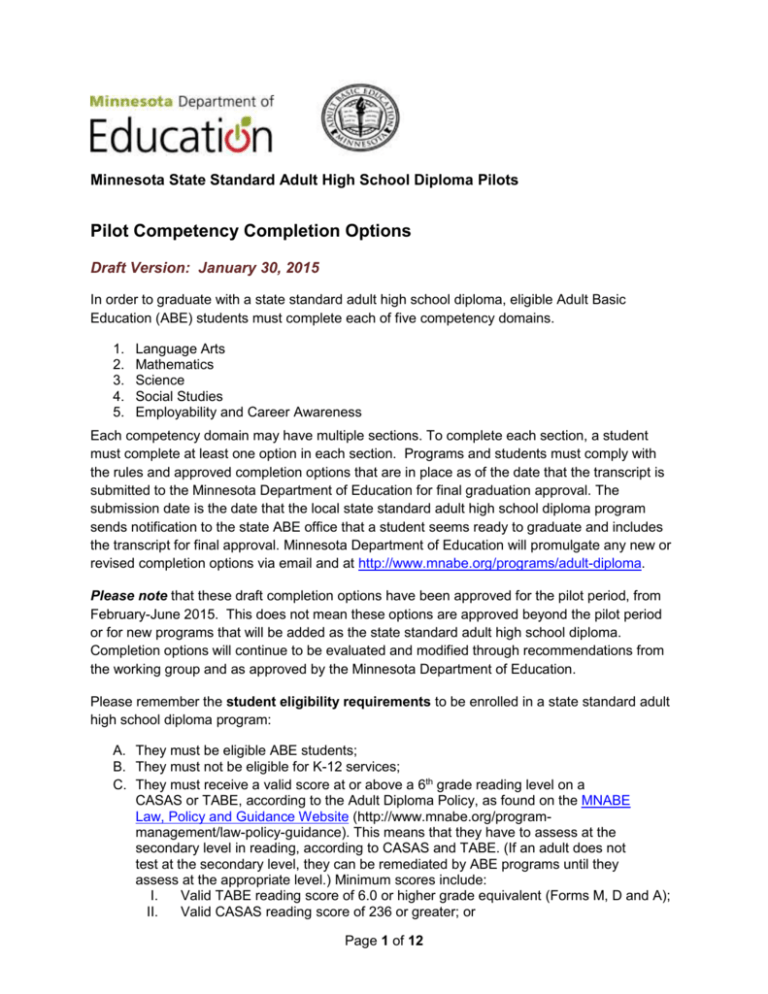
Minnesota State Standard Adult High School Diploma Pilots Pilot Competency Completion Options Draft Version: January 30, 2015 In order to graduate with a state standard adult high school diploma, eligible Adult Basic Education (ABE) students must complete each of five competency domains. 1. 2. 3. 4. 5. Language Arts Mathematics Science Social Studies Employability and Career Awareness Each competency domain may have multiple sections. To complete each section, a student must complete at least one option in each section. Programs and students must comply with the rules and approved completion options that are in place as of the date that the transcript is submitted to the Minnesota Department of Education for final graduation approval. The submission date is the date that the local state standard adult high school diploma program sends notification to the state ABE office that a student seems ready to graduate and includes the transcript for final approval. Minnesota Department of Education will promulgate any new or revised completion options via email and at http://www.mnabe.org/programs/adult-diploma. Please note that these draft completion options have been approved for the pilot period, from February-June 2015. This does not mean these options are approved beyond the pilot period or for new programs that will be added as the state standard adult high school diploma. Completion options will continue to be evaluated and modified through recommendations from the working group and as approved by the Minnesota Department of Education. Please remember the student eligibility requirements to be enrolled in a state standard adult high school diploma program: A. They must be eligible ABE students; B. They must not be eligible for K-12 services; C. They must receive a valid score at or above a 6th grade reading level on a CASAS or TABE, according to the Adult Diploma Policy, as found on the MNABE Law, Policy and Guidance Website (http://www.mnabe.org/programmanagement/law-policy-guidance). This means that they have to assess at the secondary level in reading, according to CASAS and TABE. (If an adult does not test at the secondary level, they can be remediated by ABE programs until they assess at the appropriate level.) Minimum scores include: I. Valid TABE reading score of 6.0 or higher grade equivalent (Forms M, D and A); II. Valid CASAS reading score of 236 or greater; or Page 1 of 12 III. Should unusual circumstances exist, scores from another state or nationally recognized standardized test(s) and/or an achievement profile may be presented to and deemed sufficient as threshold eligibility by the MDE state ABE office on a rare and case-by-case basis. Pilot programs should refer to the Resource and Guidance document for all the state standard adult high school diploma expectations. It can be found online at http://www.mnabe.org/programs/adult-diploma. If you have any questions about this document, please contact Brad Hasskamp, ABE Policy and Operations Specialist, at brad.hasskamp@state.mn.us or (651) 582-8594. Pilot Language Arts Competency Completion Options Section One: Reading Label Prior Experience A Prior Experience B Prior Experience C Test A Test B Test C Test D Test E Test F Test G Test H Test I Test J Potential Completion Option Completion of four English language arts high school credits. (A course credit is equivalent to a student successfully completing an academic year of study or mastering the subject matter, as determined by the local school district.) Foreign secondary English language arts course credits and completion equivalent to 4 years of high school U.S. study. (A course credit is equivalent to a student successfully completing an academic year of study or mastering the subject matter, as determined by the local school district.) Completion and passing grade in postsecondary courses that align to identified competencies in reading (and ready for postsecondary credit level coursework) Accuplacer Reading Test Score Verification (78+) GED (2002 Version) average score of 450+ on Language Arts, Reading and Social Studies and/or Science tests (with a minimum 410 score on each test) and CCRS Level E Competency Demonstration in Reading GED (2002 Version) score 450+ on Language Arts, Reading and CCRS Level E Competency Demonstration in Reading GED (2014 Version) score 150+ on RLA MCA Reading Test passing score (1050+) GRAD Reading Test passing score (50+) Passing BST Language Arts tests and ABE instruction at CCRS Level E (CCRS Level E Competency Demonstration in Reading) TOEFL Passing Scores (Reading 15+ as acceptable by postsecondary institutions and Pell eligible for college credit-level coursework) ACT Score 21+ on Reading test COMPASS English Score 47-74 and ABE instruction at CCRS Level E (CCRS Level E Competency Demonstration in Reading) Page 2 of 12 Evidence Label Test K ABE A Experiential Learning A Potential Completion Option COMPASS English Score 75+ ABE instruction at CCRS Levels D and E (CCRS Level E Competency Demonstration in Reading) Approved and standards-aligned interdisciplinary and/or culminating project (CCRS Level E Competency Demonstration in Reading) Evidence Section Two: Writing Label Prior Experience A Prior Experience B Prior Experience C Test A Test B Test C Test D Test E Test F Potential Completion Option Evidence Completion of four English language arts high school credits. (A course credit is equivalent to a student successfully completing an academic year of study or mastering the subject matter, as determined by the local school district.) and Acceptable completion of writing sample that is scored by rubric (CCRS Level E Competency Demonstration in Writing) Foreign secondary English language arts course credits and completion equivalent to 4 years of high school U.S. study. (A course credit is equivalent to a student successfully completing an academic year of study or mastering the subject matter, as determined by the local school district.) and Acceptable completion of writing sample that is scored by rubric (CCRS Level E Competency Demonstration in Writing) Completion and passing grade in postsecondary courses that align to identified competencies in writing (and ready for postsecondary credit level coursework) Accuplacer Writing Test Score Verification (86+) GED (2002 Version) average score 450+ on Language Arts, Writing and 1 or more of the following three tests: Language Arts, Reading, Science, and/or Social Studies (with a minimum 410 score on each test) and Acceptable completion of writing sample that is scored by rubric (CCRS Level E Competency Demonstration in Writing) GED (2002 Version) score 450+ on Language Arts, Writing and Acceptable completion of writing sample that is scored by rubric (CCRS Level E Competency Demonstration in Writing) GED (2014 Version) score 150+ on RLA and Acceptable completion of writing sample that is scored by rubric (CCRS Level E Competency Demonstration in Writing) MCA Writing Test Passing scores (“M” or “E” rating) and Acceptable completion of writing sample that is scored by rubric (CCRS Level E Competency Demonstration in Writing) Passing BST Writing test and ABE instruction at CCRS Level E (writing sample with Level E Competency Demonstration) Page 3 of 12 Test G Test H Test I ABE A Experiential Learning A TOEFL Passing Scores (Writing 4.0+) as acceptable by postsecondary institutions and Pell eligible for college credit-level coursework) ACT Score 18+ on Writing COMPASS English Score 47+ and ABE instruction at CCRS Level E (Writing sample with CCRS Level E Competency Demonstration in Writing) ABE instruction at CCRS Levels D and E (Writing sample with CCRS Level E Competency Demonstration in Writing) Approved and standards-aligned interdisciplinary and/or culminating project (Writing sample with CCRS Level E Competency Demonstration in Writing) Section Three: Language Label Prior Experience A Prior Experience B Prior Experience C Test A Test B Test C Test D Potential Completion Option Completion of four English language arts high school credits. (A course credit is equivalent to a student successfully completing an academic year of study or mastering the subject matter, as determined by the local school district.) and Acceptable completion of writing sample that is scored by rubric (CCRS Level E Competency Demonstration in Language) Foreign secondary English language arts course credits and completion equivalent to 4 years of high school U.S. study. (A course credit is equivalent to a student successfully completing an academic year of study or mastering the subject matter, as determined by the local school district.) and Acceptable completion of writing sample that is scored by rubric (CCRS Level E Competency Demonstration in Language) Completion and passing grade in postsecondary courses that align to identified competencies in language (and ready for postsecondary credit level coursework) Accuplacer Reading Test Score Verification (78+) and Writing Test Score Verification (86+) GED (2002 Version) average score 450+ on Language Arts, Writing and 1 or more of the following three tests: Language Arts, Reading, Science, and/or Social Studies (with a minimum 410 score on each test) and Acceptable completion of writing sample that is scored by rubric (CCRS Level E Competency Demonstration in Language) GED (2002 Version) score 450+ on Language Arts, Writing and Acceptable completion of writing sample that is scored by rubric (CCRS Level E Competency Demonstration in Language) GED (2014 Version) score 150+ on RLA and Acceptable completion of writing sample that is scored by rubric (CCRS Level E Competency Demonstration in Language) Page 4 of 12 Evidence Label Test E Test F Test G Test H Test I ABE A Experiential Learning A Potential Completion Option MCA Language Arts Tests passing scores (50+ on Reading and “M” or “E” on Writing) and Acceptable completion of writing sample that is scored by rubric (CCRS Level E Competency Demonstration in Language) Passing BST Reading and Writing tests and ABE instruction (writing sample with Level E Competency Demonstration in Language) TOEFL Passing Scores (Reading 15+ and Writing 4.0+ as acceptable by postsecondary institutions and Pell eligible for college credit-level coursework) ACT Score 18+ on Writing and 21+ on Reading test COMPASS English Score 47+ and ABE instruction at CCRS Level E (Writing sample with CCRS Level E Competency Demonstration in Writing) ABE instruction at CCRS Levels D and E (CCRS Level E Competency Demonstration in Language) Approved and standards-aligned interdisciplinary and/or culminating project (Writing sample with CCRS Level E Competency Demonstration in Language) Evidence Section Four: Speaking and Listening Label Prior Experience A Test A Test B Test C ABE A Experiential Learning A Potential Completion Option Completion and passing grade in postsecondary courses that align to identified competencies in speaking and listening (and ready for postsecondary credit level coursework) TOEFL Passing Scores (Speaking 3.5+ and Listening 14+) as acceptable by postsecondary institutions and Pell eligible for college credit-level coursework ACCESS Proficiency Scores (Listening 4.5+ and Speaking 4.5+ or Oral Language Composite 4.5+) ACTFL Oral Language Proficiency Assessment (OPI and OPIC) Score “Intermediate Mid” or higher ABE instruction at CCRS Levels D and E (CCRS Level E Competency Demonstration in Speaking and Listening) and (for students whose first language is not English) BEST Plus 439+ or CASAS Listening 200+ Approved and standards-aligned interdisciplinary and/or culminating project/presentation (CCRS Level E Competency Demonstration in Speaking and Listening) and (for students whose first language is not English) BEST Plus 439+ or CASAS Listening 200+ Page 5 of 12 Evidence Pilot Mathematics Competency Completion Options Label Prior Learning A Prior Learning B Prior Learning C Test A Test B Test C Test D Test E Test F Test G Test H ABE A Potential Completion Option Completion of three math high school credits covering algebra, geometry and measurement and data, statistics and probability. (A course credit is equivalent to a student successfully completing an academic year of study or mastering the subject matter, as determined by the local school district.) and CASAS Math valid score 211+ or TABE Total Math valid score 442+ (prerequisite) Foreign secondary mathematics course credits and completion equivalent to 3 years of high school U.S. study covering algebra, geometry and measurement and data, statistics and probability. (A course credit is equivalent to a student successfully completing an academic year of study or mastering the subject matter, as determined by the local school district.) and CASAS Math valid score 211+ or TABE Total Math valid score 442+ (prerequisite) Completion and passing grade in postsecondary courses covering algebra, geometry and measurement and data, statistics and probability that align to mathematics competencies at CCRS Levels D and E (and ready for postsecondary credit level coursework) GED (2002 Version) score 450+ on Mathematics and ABE instruction at CCRS Level E (CCRS Level E Competency Demonstration in Mathematics) GED (2014 Version) Mathematics Passing Score (150+) Accuplacer Math scores (a minimum Arithmetic Score 56+ and Elementary Algebra 76+) MCA Math Test Passing score (“M” or “E” rating) GRAD Math Test passing score ACT Score 16+ on Math test COMPASS Pre-Algebra test score of 55+ COMPASS Algebra test score of 35+ ABE instruction in Levels D and E covering algebra, geometry and measurement and data, statistics and probability (CCRS Level E Competency Demonstration in Mathematics) and CASAS Math valid score 211+ or TABE Total Math valid score 442+ (prerequisite) Page 6 of 12 Evidence Label Experiential Learning A Potential Completion Option Approved and standards-aligned interdisciplinary and/or culminating project(s) covering algebra, geometry and measurement and data, statistics and probability (CCRS Level E Competency Demonstration in Mathematics) and CASAS Math valid score 211+ or TABE Total Math valid score 442+ (prerequisite) Page 7 of 12 Evidence Pilot Science Competency Completion Options Section One: Nature of Science and Engineering Label Prior Experience A Prior Experience B Prior Experience C Test A Test B ABE A Experiential Learning A Potential Completion Option Passing/completion of high school science course in the nature of science and engineering Passing/completion of foreign high school science course in the nature of science and engineering Passing/completion of postsecondary course in the nature of science and engineering GED (2002 Version) Science test passing score (410+) GED (2014 Version) Science test passing score (150+) ABE instruction (verified demonstration of Minnesota K-12 academic secondary-level competencies in the nature of science and engineering) Approved and standards-aligned interdisciplinary and/or culminating project with written report and/or oral presentation (verified demonstration of Minnesota K-12 academic secondarylevel competencies in the nature of science and engineering) Evidence Section Two: Life Science Label Prior Experience A Prior Experience B Prior Experience C Test A Test B ABE A Potential Completion Option Passing/completion of high school science course in life science Experiential Learning A Approved and standards-aligned interdisciplinary and/or culminating project with written report and/or oral presentation (verified demonstration of Minnesota K-12 academic secondarylevel competencies in life science) Evidence Passing/completion of foreign high school science course in life science Passing/completion of postsecondary course in life science GED (2002 Version) Science test passing score (410+) GED (2014 Version) Science test passing score (150+) ABE instruction (verified demonstration of Minnesota K-12 academic secondary-level competencies in life science) Section Three: Physical Science Label Prior Experience A Prior Experience B Prior Experience C Test A Test B ABE A Experiential Learning A Potential Completion Option Passing/completion of high school science course in physical science Passing/completion of foreign high school science course in physical science Passing/completion of postsecondary course in physical science GED (2002 Version) Science test passing score (410+) GED (2014 Version) Science test passing score (150+) ABE instruction (verified demonstration of Minnesota K-12 academic secondary-level competencies in physical science) Approved and standards-aligned interdisciplinary and/or culminating project with written report and/or oral presentation Page 8 of 12 Evidence Label Potential Completion Option (verified demonstration of Minnesota K-12 academic secondarylevel competencies in physical science) Evidence Section Four: Earth and Space Science Label Prior Experience A Prior Experience B Prior Experience C Test A Test B ABE A Experiential Learning A Potential Completion Option Passing/completion of high school science course in earth and space science Passing/completion of foreign high school science course in earth and space science Passing/completion of postsecondary course in earth and space science GED (2002 Version) Science test passing score (410+) GED (2014 Version) Science test passing score (150+) ABE instruction (verified demonstration of Minnesota K-12 academic secondary-level competencies in earth and space science) Approved and standards-aligned interdisciplinary and/or culminating project with written report and/or oral presentation (verified demonstration of Minnesota K-12 academic secondarylevel competencies in earth and space science) Page 9 of 12 Evidence Pilot Social Studies Competency Completion Options Section One: U.S. Government and Citizenship Label Prior Experience A Prior Experience B Test A Test B Test C ABE A Experiential Learning A Completion Option Passing/completion of high school social studies course in U.S. Government and Citizenship. Completion and passing grade in postsecondary course in U.S. Government and citizenship GED (2002 Version) Social Studies passing score 410+ GED (2014 Version) Social Studies passing score 150+ Passing U.S. Citizenship Naturalization Test ABE instruction (verified demonstration of secondary-level competencies in the U.S. Government and citizenship) Approved and standards-aligned interdisciplinary and/or culminating project with written report and/or oral presentation (verified demonstration of secondary-level competencies in the U.S. Government and citizenship) Evidence Section Two: Economics Label Prior Experience A Prior Experience B Test A Test B ABE A Experiential Learning A Completion Option Passing/completion of high school social studies course in economics. Completion and passing grade in postsecondary course in economics GED (2002 Version) Social Studies passing score 410+ GED (2014 Version) Social Studies passing score 150+ ABE instruction (verified demonstration of secondary-level competencies in economics) Approved and standards-aligned interdisciplinary and/or culminating project with written report and/or oral presentation (verified demonstration of secondary-level competencies in economics) Evidence Section Three: History Label Prior Experience A Prior Experience B Test A Test B ABE A Experiential Learning A Completion Option Passing/completion of high school social studies course in history Evidence Completion and passing grade in postsecondary course in history GED (2002 Version) Social Studies passing score 410+ GED (2014 Version) Social Studies passing score 150+ ABE instruction (verified demonstration competencies from Minnesota K-12 academic standards in history) Approved and standards-aligned interdisciplinary and/or culminating project with written report and/or oral presentation (verified demonstration competencies from Minnesota K-12 academic standards in history) Section Four: Geography Label Prior Experience A Completion Option Passing/completion of high school social studies course in geography Page 10 of 12 Evidence Label Prior Experience B Test A Test B ABE A Experiential Learning A Completion Option Completion and passing grade in postsecondary course in geography GED (2002 Version) Social Studies passing score 410+ GED (2014 Version) Social Studies passing score 150+ ABE instruction (verified demonstration of competencies from Minnesota K-12 academic standards in geography) Approved and standards-aligned interdisciplinary and/or culminating project with written report and/or oral presentation (verified demonstration of competencies from Minnesota K-12 academic standards in geography) Page 11 of 12 Evidence Pilot Employability, Career Development and Digital Literacy Competency Completion Options Section One: Resume Completion Label Experiential Learning A Potential Completion Option Resume Completion Evidence Section Two: Self-Management Label ABE A Potential Completion Option Staff verification through participation in advising and through adult diploma program participation (demonstration of competencies in ACES TIF Self-Management) Evidence Section Three: Developing a Future Pathway Label ABE A Experiential Learning A Experiential Learning B Potential Completion Option ABE instruction (demonstration of competencies in ACES TIF Developing a Future Pathway) Guided career packet completion with workforce development staff (demonstration of competencies in ACES TIF Developing a Future Pathway) Approved and aligned independent project that utilizes online resources, such as iseek.org, Minnesota Career Information System, GPS LifePlan, mymncareers.org (demonstration of competencies in ACES TIF Developing a Future Pathway) Evidence Section Four: Navigating Systems Label Prior Experience A ABE A Experiential Learning A Potential Completion Option An employer or course instructor verifies in writing that the learner has met all competencies in the ACES TIF Navigating Systems ABE instruction (demonstration of competencies in ACES TIF Navigating Systems) Approved and aligned independent project - can include verified volunteer experience and work experience (demonstration of competencies in ACES TIF Navigating Systems) Evidence Section Five: Digital Literacy Label Test A ABE A Potential Completion Option Northstar Digital Literacy Assessments (5 tests with 85%+ correct per test in a proctored environment: 1. Email 2. Basic computer 3. World Wide Web 4. Word 5. Windows OR Mac OS) Evidence of competency demonstrated through the application of skills in an ABE classroom, DL platform, or employment situation (using the standards as a checklist/rubric) and typing speed verification (15+ words/minute) Page 12 of 12 Evidence
